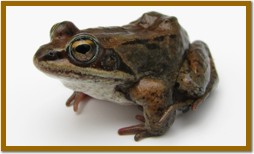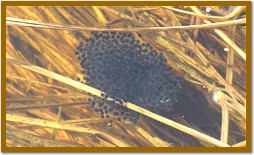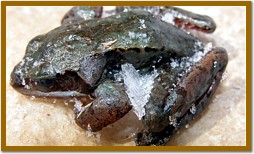
Biology of the Wood Frog |
(Click thumbnail images for larger photos.) |
Name Derivation
The common name of the Wood Frog is pretty obvious, it's a frog that is found mainly in wooded areas. The scientific name derives as follows:
Lithobates (from Greek) - meaning a stone (Litho) that walks or haunts (bates), sylvaticus (from Latin) - pertaining to woods or forests.
Description
 Wood frogs can grow to 50 mm (2
inches) in body length. Stretched out, a frog with a 50 mm long body
might reach 140 mm from its snout to the tip of its toes. Females tend
to be larger than males. Wood frogs are quite variable in colour, but
are usually a mottled brown (the colour of dead leaves on the forest
floor), with a black mask-like patch from their eyes to the line of
the jaw. Females are usually more rusty red in colour.
Wood frogs can grow to 50 mm (2
inches) in body length. Stretched out, a frog with a 50 mm long body
might reach 140 mm from its snout to the tip of its toes. Females tend
to be larger than males. Wood frogs are quite variable in colour, but
are usually a mottled brown (the colour of dead leaves on the forest
floor), with a black mask-like patch from their eyes to the line of
the jaw. Females are usually more rusty red in colour.
Distribution
The wood frog is the most widely distributed amphibian occurring in Manitoba. It is the only frog that can be found throughout the entire province of Manitoba. In North America it occurs throughout Canada, as far north as the tree line (the edge of the Arctic tundra) and through most of the northern United States as far south as Georgia in the east.
Click here for a Map of the range of the Wood Frog.
Habitat
 As its name implies the wood frog
is found mainly in wooded areas, but can live in meadows, or even urban
areas. Populations of wood frogs can survive just about anywhere there
is enough water available in the spring in which to breed. They prefer
to breed in "vernal ponds" -
small, temporary ponds arising from the spring snow melt. Any pond that
holds water until the end of June can be used for rearing their young.
Wood frogs will breed in larger bodies of water including lakes and
slow flowing streams, but prefer temporary ponds which do not harbour
fish and other predators that would eat both eggs and tadpoles.
As its name implies the wood frog
is found mainly in wooded areas, but can live in meadows, or even urban
areas. Populations of wood frogs can survive just about anywhere there
is enough water available in the spring in which to breed. They prefer
to breed in "vernal ponds" -
small, temporary ponds arising from the spring snow melt. Any pond that
holds water until the end of June can be used for rearing their young.
Wood frogs will breed in larger bodies of water including lakes and
slow flowing streams, but prefer temporary ponds which do not harbour
fish and other predators that would eat both eggs and tadpoles.
Food
Adult wood frogs eat insects and other small invertebrates. Like most frogs and toads they will eat just about any animal that will fit into their mouths! The tadpoles are primarily herbivorous, eating algae and decaying plant matter, but they will eat dead animal flesh (even other dead tadpoles) if it is available. They have small beak-like mouths with which they rasp or scrape away at food items. Adults have wide mouths and a sticky tongue they can flick out to capture prey.
Wood frogs can be raised from egg to small froglets in less than 50 days. All that is required is a container with clean, oxygenated water and simple foods, such as boiled lettuce or fish food (commercial flakes). Check out: Wood Frogs in the Class Room and Frog Log. |
Reproduction
Wood frogs make their way to breeding ponds as soon as the weather allows in the spring, often as early as mid-April in southern Manitoba (though they have recently been recorded laying eggs in late March!). Males call to attract females throughout the day, but evening is usually the time of greatest breeding activity. The call of the wood frog sounds like "quork, quork, quork".
Play the mating call of a Wood Frog
 Males clasp onto the backs of females
and deposit sperm into the water as the female lays her eggs. The egg
mass, which may contain many hundreds of eggs, is attached to vegetation
near the surface of the water. The eggs usually hatch in under 1 week,
but cold weather resulting in cooling of the pond can slow development.
Growth of the tadpoles depends on water temperature and food availability.
In the wild, tadpoles may transform into their adult form by late June
or early July. In captivity, with warmer temperatures and assured food
supplies they can transform by mid-June. Growth and transformation
can be delayed by as much as 2 months if food is limiting in the wild.
Newly transformed frogs, called froglets, are quite small, often only
10 mm (snout to vent). They require 2 or more years to reach full adult
size.
Males clasp onto the backs of females
and deposit sperm into the water as the female lays her eggs. The egg
mass, which may contain many hundreds of eggs, is attached to vegetation
near the surface of the water. The eggs usually hatch in under 1 week,
but cold weather resulting in cooling of the pond can slow development.
Growth of the tadpoles depends on water temperature and food availability.
In the wild, tadpoles may transform into their adult form by late June
or early July. In captivity, with warmer temperatures and assured food
supplies they can transform by mid-June. Growth and transformation
can be delayed by as much as 2 months if food is limiting in the wild.
Newly transformed frogs, called froglets, are quite small, often only
10 mm (snout to vent). They require 2 or more years to reach full adult
size.
Watch Wood Frog eggs become froglets in this NatureNorth Critter Video!
Attention all amphibian lovers!If you want to help conserve amphibians in Manitoba then get involved with the Manitoba Herps Atlas! When you find a critter enter a record to help build a province-wide database of species' locations and natural history. |
Habits
After the spring breeding period, adult frogs leave the ponds to spend the summer foraging for insects, worms and other invertebrates. In summer they are most active at night. In cooler times of the year (spring and fall) wood frogs are more active during the day. The home range of individual frogs can be as small as 100 square metres (0.01 ha or 0.03 acre), but is quite variable. Wood frogs spend winter on land, under leaf litter, logs or rocks. They are one of several species of frogs that can tolerate freezing of their body tissues.
Hibernating on land and experiencing freezing may seem like a drastic lifestyle, but it has some real rewards. Chief among these are access to habitats far from permanent bodies of water and the ability to start breeding early. Without the need for large bodies of water for hibernation, wood frogs can live in areas far from permanent water bodies. The forest floor where they lie dormant for the winter warms quicker in the spring than do large ponds, marshes or lakes, freeing the wood frog to start its breeding cycle much earlier. The vernal ponds that the wood frog uses for breeding also warm faster and stay warmer than larger water bodies allowing for rapid growth of tadpoles in an environment largely free from aquatic predators. A new crop of froglets is launched by late June or early July before summer's heat dries out the vernal ponds.
(There are real disadvantages to hibernating in ponds, too, see our Winter Kill article.)
 How do wood frogs have the energy
to mate and produce large masses of eggs first thing in the spring,
before most of the insects and invertebrates they eat have emerged form
hibernation? They take it into cold storage with them! By late fall
the frogs have stored enough fat and glycogen (a storage form of the
sugar, glucose) to get them
through the breeding season and sustain them until new prey appears
in late spring. Also, they will have produced their eggs and sperm before heading into winter; those freeze undamaged, too.
How do wood frogs have the energy
to mate and produce large masses of eggs first thing in the spring,
before most of the insects and invertebrates they eat have emerged form
hibernation? They take it into cold storage with them! By late fall
the frogs have stored enough fat and glycogen (a storage form of the
sugar, glucose) to get them
through the breeding season and sustain them until new prey appears
in late spring. Also, they will have produced their eggs and sperm before heading into winter; those freeze undamaged, too.
Being cold blooded does have its advantages. While mammals and birds must meter out their precious stores of food and fat just to stay warm and endure the winter, wood frogs and other cold-blooded critters emerge from winter fat and fit.
Thanks for learning about Wood Frogs! Bye for now.
Acknowledgements
Thanks to Bill Preston, Curator (retired) of Reptiles, Amphibians and Fishes at the Manitoba Museum of Man and Nature for information and the frog sounds. Thanks also to Jan and Ken Storey at Carleton University, Ottawa for some information and images.
MORE Frog Stuff
Follow this link for more Frog and Toad Calls.
Other NatureNorth articles: Wood Frogs in the Class Room & Frog Log. (Our record of raising tadpoles.)
For kids: The Amphibians of Manitoba (In 1-Nature Place)
For more on "frog-sicles" and other cryogenic creatures check out our Winter Issue article Frozen Alive.
Help NatureNorth produce more great articles:
